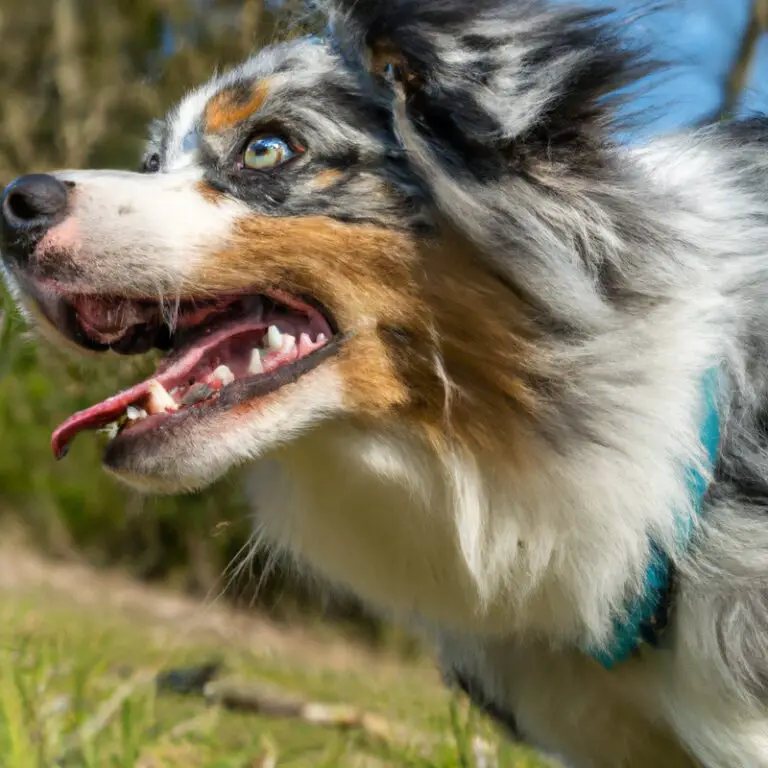How Do Australian Shepherds Behave When Introduced To New Amphibians?
Key Takeaways:
- Australian Shepherds show a variety of behavioral responses when introduced to new amphibians.
- The behavior of Australian Shepherds towards new amphibians is heavily influenced by socialization and past experiences.
- There is no uniform reaction among Australian Shepherds when encountering new amphibians, highlighting the individuality of their behavior.
- Proper training and gradual exposure can help Australian Shepherds adapt more positively to new amphibians.
Are you a proud Australian Shepherd owner who loves exploring the great outdoors? Then you must know that when it comes to introducing your beloved four-legged friend to new experiences, there’s always a hint of excitement mixed with a dash of uncertainty.
But have you ever wondered how Australian Shepherds behave when they encounter amphibians?
As an expert in dog behavior, I’ve spent years studying these fascinating canines. In this article, I’ll shed light on their natural instincts, explain the importance of proper introduction techniques, and offer safety measures to ensure a harmonious coexistence between Australian Shepherds and their amphibian friends.
Let’s dive in!
Here is a table that can be used to provide information about how Australian Shepherds behave when introduced to new amphibians: “`markdown| Behavior | Description |
| Curiosity | Australian Shepherds are generally curious creatures and may approach the new amphibian with interest. |
| Friendly | If properly socialized, Australian Shepherds may show friendliness towards the amphibian and may even try to play with it. |
| Cautious | Some Australian Shepherds may exhibit caution when encountering a new amphibian, especially if it displays defensive behavior. |
| Vigilant | Australian Shepherds are naturally alert and may closely watch the movements of the amphibian to assess any potential threat. |
| Herding Instinct | Due to their herding background, some Australian Shepherds may try to corral or control the movement of the amphibian. |
| Anxiety | In some cases, Australian Shepherds may display signs of anxiety or stress when introduced to a new amphibian, especially if they are not familiar with such encounters. |
Australian Shepherds and Their Natural Instincts
Herding Instincts and Prey Drive of Australian Shepherds
Australian Shepherds have a strong herding instinct and prey drive. This means that they naturally have a tendency to gather and control groups of animals, such as livestock.
Their herding instincts can also be seen in their behavior towards smaller animals, including amphibians.
They may try to chase, stalk, or nip at them, due to their prey drive. It’s important to keep this in mind when introducing Australian Shepherds to new amphibians, as they may exhibit this instinctive behavior.
Proper training and socialization can help manage and redirect their instinctual behaviors in a safe and controlled manner.
Adaptability and Curiosity of Australian Shepherds
Australian Shepherds are known for their adaptability and curiosity. These traits make them excellent companions for various lifestyles and environments.
They can easily adjust to new situations and surroundings, making them versatile dogs.
Whether it’s a change in living arrangements or encountering new people or animals, Australian Shepherds are quick to adapt and show interest. Their curiosity drives them to explore and learn about their surroundings.
They are naturally inquisitive and enjoy discovering new things.
When introduced to new amphibians, Australian Shepherds may exhibit curiosity towards these creatures. They may approach them, sniff them, and observe their movements.
It’s important to monitor the interaction to ensure the safety of both the dog and the amphibian.
Australian Shepherds’ adaptability and curiosity can be harnessed through proper training and socialization. By exposing them to new experiences and stimuli from a young age, they learn to adapt and behave appropriately in different situations.
This includes interactions with other animals, such as amphibians.
Gradual exposure and positive reinforcement training methods can help them understand boundaries and develop a positive association with new encounters. While their curiosity and adaptability are valuable traits, it’s essential to introduce Australian Shepherds to new amphibians in a controlled and supervised environment.
This ensures the safety of both the dog and the amphibians.
By understanding their behavior and reactions, and implementing appropriate introduction techniques, we can create a positive and safe experience for all parties involved.

Introducing Australian Shepherds to Amphibians
Understanding the Behavior and Reactions of Australian Shepherds
Understanding the behavior and reactions of Australian Shepherds is important when introducing them to new amphibians. These dogs are known for their intelligence and athleticism, which can influence their behavior in various situations.
Australian Shepherds have a strong instinct to herd, so they may display herding behaviors when they encounter amphibians.
This can include nipping, chasing, or trying to corral them. It’s essential to monitor these interactions closely to ensure the safety of both the dog and the amphibians.
Additionally, Australian Shepherds are generally adaptable and curious dogs.
They may show interest in amphibians and want to explore them. This curiosity can be channeled through gradual exposure and positive reinforcement training methods.
It’s crucial to introduce Australian Shepherds to amphibians in a controlled and safe environment.
This includes providing proper supervision and ensuring the frog or toad is not harmful to the dog. Some amphibians may have toxins, so it’s important to distinguish between harmful and non-harmful species.
Lastly, it’s important to address any fear or aggressive behavior that Australian Shepherds may exhibit towards amphibians.
Proper socialization with other animals and consistent training can help mitigate these reactions. Understanding the behavior and reactions of Australian Shepherds when introduced to new amphibians is key to creating a positive and safe environment for both the dog and the amphibians.

Importance of Proper Introduction Techniques
Proper introduction techniques are crucial when introducing Australian Shepherds to new amphibians. It is important to approach the introduction with care and patience to ensure a positive experience for both the dog and the amphibian.
One of the main reasons why proper introduction techniques are important is to prevent any fear or aggression from the Australian Shepherd towards the amphibian.
By introducing them slowly and gradually, it allows the dog to become familiar and comfortable with the new creature. Additionally, proper introduction techniques also help in establishing a positive association between the Australian Shepherd and the amphibian.
This can be done by using rewards and positive reinforcement during the introduction process.
This helps the dog to understand that the presence of the amphibian is a good thing and encourages a calm and friendly attitude. Another crucial aspect of proper introduction techniques is ensuring the safety of both the Australian Shepherd and the amphibian.
By monitoring their interactions and providing a controlled environment, potential accidents or harm can be prevented.
It is also important to distinguish between harmful and non-harmful amphibians to ensure the safety of the dog.

Preparing Australian Shepherds for New Amphibian Encounters
Socializing Australian Shepherds with other Animals
When it comes to socializing Australian Shepherds with other animals, it’s important to take a gradual and positive approach. Start by introducing your Aussie to well-behaved and friendly animals in a controlled environment.
Allow them to sniff and interact while closely monitoring their behavior.
Positive reinforcement through treats and praise can help create positive associations. Avoid forcing interactions and give your dog the opportunity to approach at their own pace.
Remember, every dog is different, so be patient and provide plenty of opportunities for socialization.
Gradual Exposure and Positive Reinforcement Training Methods
When it comes to introducing Australian Shepherds to new amphibians, gradual exposure and positive reinforcement training methods are essential. By taking a slow and controlled approach, you can help your dog acclimate to these new creatures without overwhelming them.
Start by exposing your dog to images or sounds of amphibians and reward them with treats or praise for calm behavior.
Gradually introduce them to real amphibians in a controlled environment, always keeping their safety and comfort in mind. Positive reinforcement, such as giving treats or verbal praise, will help reinforce good behavior and create a positive association with amphibians.
With patience and consistency, your Australian Shepherd can learn to behave calmly around new amphibians.
Safety Measures for Australian Shepherds and Amphibians
Monitoring Interactions and Supervision
When it comes to monitoring interactions between Australian Shepherds and amphibians, supervision is key. It’s important to keep a close eye on their interactions to ensure the safety of both the dog and the amphibian.
By actively supervising their interactions, you can quickly intervene if needed and prevent any potential harm or stress.
Supervision involves being present and attentive during the interactions. You should stay close by and actively observe their behavior.
Look for signs of aggression or excessive interest from the Australian Shepherd, as they may try to chase, nip, or prey on the amphibian.
If you notice any concerning behavior, it’s important to separate them and redirect the dog’s attention to something else. Maintaining a safe and controlled environment is also essential.
Make sure the enclosure or area where the interactions take place is secure and escape-proof for the amphibian.
Provide hiding spots or barriers to prevent the Australian Shepherd from getting too close or making direct contact with the amphibian. Additionally, consider using barriers such as baby gates or crates to separate them during initial introductions.
This can allow them to become familiar with each other’s presence without any direct physical contact.
As they become more accustomed to each other, supervised and controlled interactions can be gradually increased. Remember, the key is to prioritize the safety and well-being of both the Australian Shepherd and the amphibian.
By actively monitoring their interactions and providing a secure environment, you can help ensure a positive and safe experience for both of them.
Ensuring a Safe and Controlled Environment
To ensure a safe and controlled environment when introducing Australian Shepherds to amphibians, there are a few key things to keep in mind. First, it’s important to create a secure and supervised space for these interactions.
This could be a fenced-in yard or an area with barriers to prevent the dog from wandering off or getting too close to the amphibians.
Next, it’s essential to establish clear boundaries and rules for the dog. Teach them the “leave it” command, which will help prevent them from chasing or attempting to harm the amphibians.
Consistency and positive reinforcement training methods can go a long way in reinforcing these boundaries.
Additionally, it’s crucial to carefully select which amphibians to introduce to the Australian Shepherd. Make sure to distinguish between harmful and non-harmful species and only introduce them to safe and non-toxic amphibians.
It’s best to consult with an expert or do thorough research before bringing any amphibians into the environment.
Potential Challenges and Considerations
Distinguishing Between Harmful and Non-Harmful Amphibians
When it comes to distinguishing between harmful and non-harmful amphibians, there are a few key factors to consider. One important aspect is their appearance.
It’s crucial to familiarize yourself with the characteristics of different species to identify potential threats.
Take note of distinguishing features such as bright colors or patterns, which may indicate toxicity or venom. Another aspect to consider is the region in which you live.
Research local amphibians and their potential dangers.
By being aware of the harmful species in your area, you can take necessary precautions and keep your Australian Shepherd safe. Remember, it’s always a good idea to consult with a local reptile and amphibian expert for accurate information and guidance.
Dealing with Fear or Aggressive Behavior in Australian Shepherds
Dealing with Fear or Aggressive Behavior in Australian Shepherds can be challenging, but there are effective methods to manage these behaviors.
- Patience and understanding are key when dealing with fear in Australian Shepherds. Slowly expose them to new situations and provide positive reinforcement to help them overcome their fears. Gradual desensitization can be helpful in reducing fear responses.
- Aggressive behavior should be addressed with professional guidance. Seek the assistance of a certified dog trainer or behaviorist who specializes in working with Australian Shepherds. They can help assess the underlying causes of aggression and develop a behavior modification plan.
- It’s important to avoid punishment as it can increase anxiety or aggression in Australian Shepherds. Instead, focus on positive reinforcement training techniques to encourage desired behaviors.
- Consistency is crucial when dealing with fear or aggression. Establish clear boundaries and rules for your Australian Shepherd, and ensure that all family members are consistent in their handling and training methods.
- Socialization is also important in preventing fear and aggression in Australian Shepherds. Expose them to various people, animals, and environments from a young age to help them feel comfortable and confident.
- Regular exercise and mental stimulation play a significant role in managing fear and aggression. Australian Shepherds are energetic dogs that require plenty of physical and mental activities to keep them content and balanced.
- Remember, dealing with fear or aggression in Australian Shepherds requires patience, consistency, and professional guidance when necessary. With the right approach, these behaviors can be managed effectively, and your Australian Shepherd can live a happy and well-adjusted life.
Final Verdict
Australian Shepherds have a natural herding instinct and prey drive that can influence their behavior when introduced to new amphibians. It is important to understand their reactions and employ proper introduction techniques to ensure a positive experience for both the dog and the amphibian.
Gradual exposure and positive reinforcement training methods help prepare Australian Shepherds for new encounters.
Safety measures, such as monitoring interactions and creating a controlled environment, are essential to prevent any harm. Overall, with the right approach and understanding, Australian Shepherds can adapt well to amphibian encounters.








